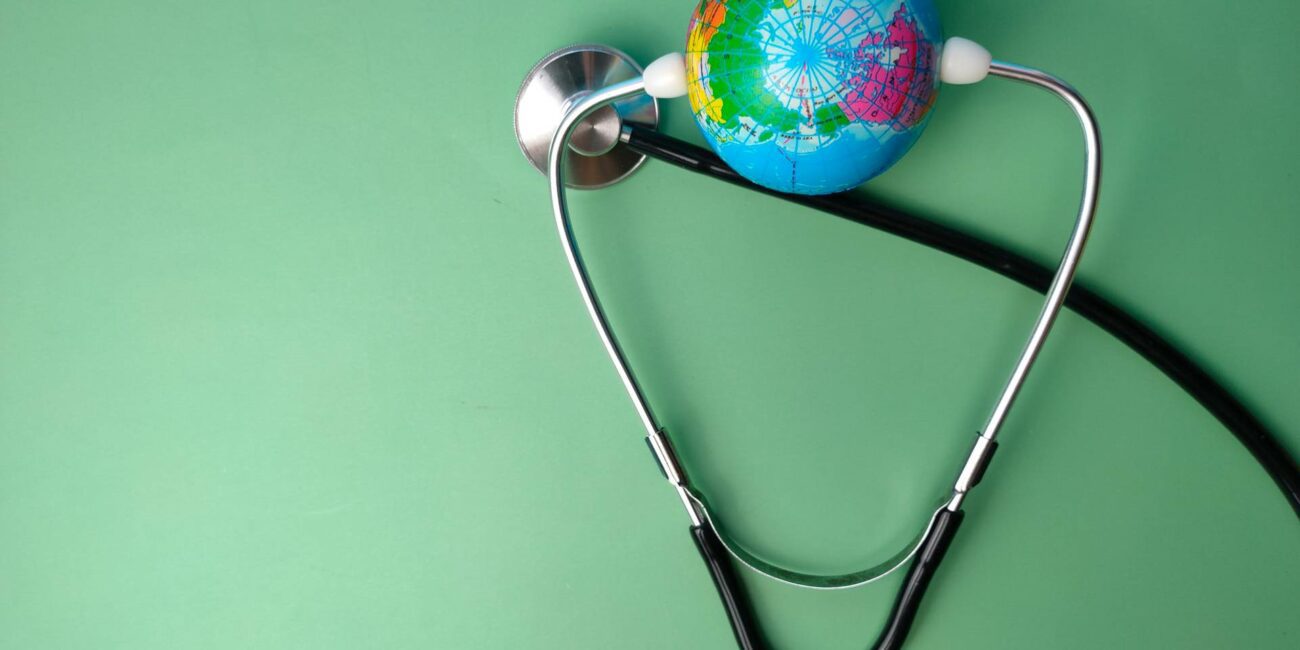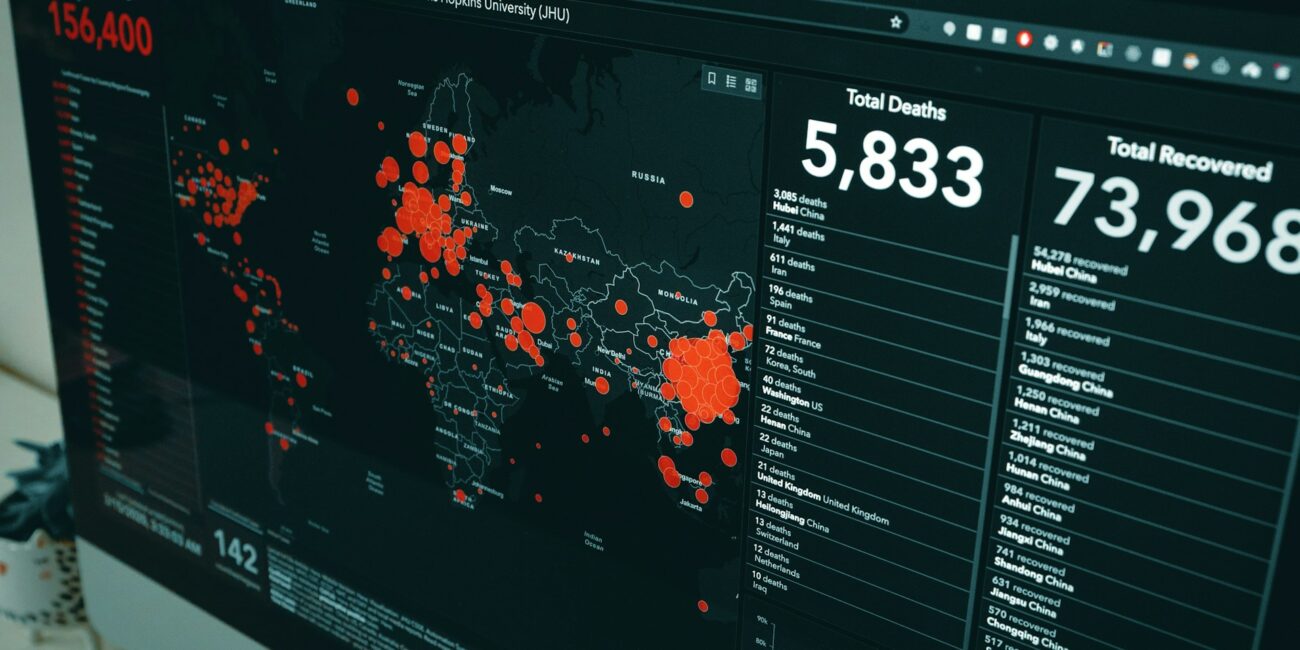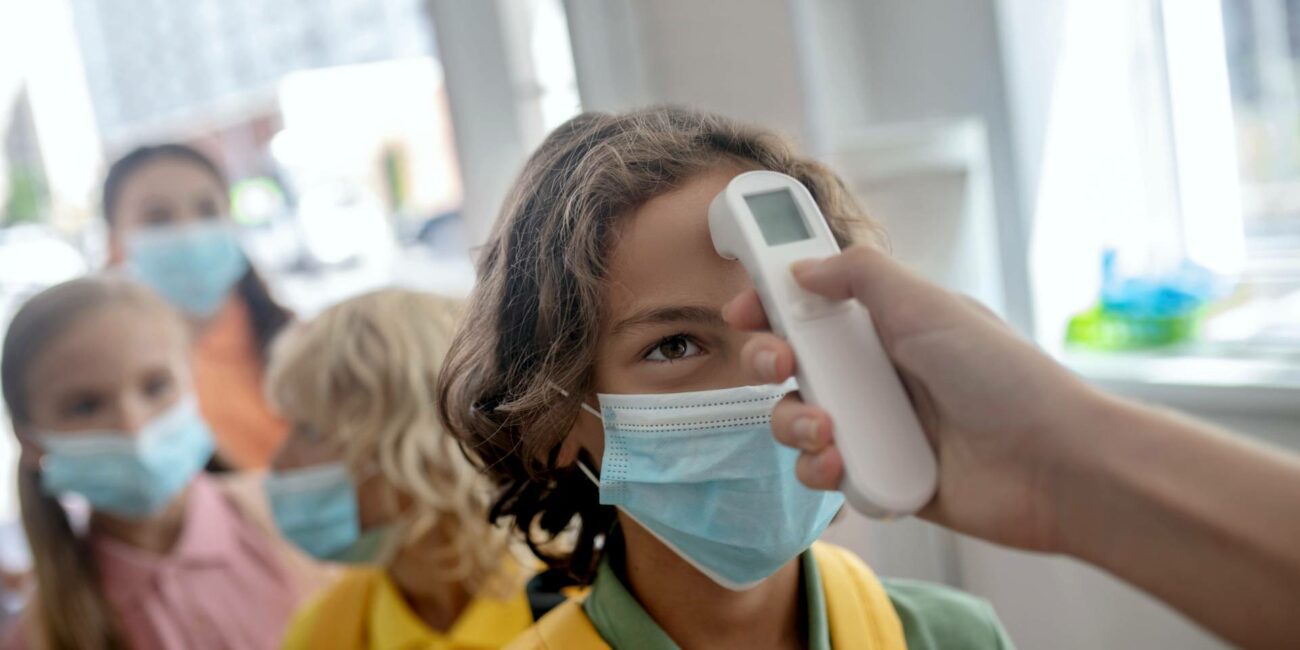by Dr R. Iván Iriarte, MD, MS
Since the World Health Organization (WHO) declared the COVID-19 global pandemic, many issues have arisen that run contrary to historical precedents and known and practiced public health principles of the last century. This article discusses some of these issues: assumptions made without evidence, the incorrect case definition, PCR diagnostic test problems, the impact of these two factors on morbidity and mortality estimates, school closures, facemasks, lockdowns and their effects on children.
Assumptions about SARS-CoV-2 made without evidence – the creation of panic
Panic has been spread among the general population since the beginning of the pandemic, based on the idea of “asymptomatic transmission”. This idea was strongly influenced by a case report in Germany, in which an infection was attributed to contact with an asymptomatic person (1). Further investigation revealed that this person had actually been sick and had been suppressing her symptoms with medication (2). The original misleading paper was never rectified. Based on this, and limited case reports from China, the “experts” began to promote the idea that this virus behaves differently to other respiratory viruses. All prior knowledge indicates that epidemics are not driven by asymptomatic individuals (3, 4). However, the decision-makers in this epidemic determined that this does not apply to COVID-19 and every single individual we encounter could be an infectious person capable of killing us. This is contrary to conventional reasoning in medicine and public health. Decisions have always been based on prior knowledge, until there is compelling evidence to disprove what we thought we knew. Articles in the literature have found that secondary transmission by asymptomatic individuals is very low (5, 6, 7). In a cohort study with a very large sample size, no one became infected among 1,174 contacts of 300 asymptomatic subjects who had tested positive for SARS-CoV-2 (8).
Another assumption promoted by the “experts” in this epidemic is the idea that the general population would be immunologically “naive” to this virus and thus 100% susceptible to develop the disease. This is again not consistent with previous knowledge about human immunity to viral agents. Cross-immunity is a well-known fact. It is not reasonable to assume that the entire population is immunologically susceptible to SARS-CoV-2, when in fact it is very likely that many individuals have at least partial immunity to the virus due to prior infection with similar viruses or agents with similar antigenic properties. There are several studies showing that individuals have immunity to SARS-CoV-2 by T-Cell mediated mechanisms (9, 10, 11, 12, 13).
Problems with the “case” definition
Over centuries of epidemic management, a case always constituted a sick individual who presented a series of established clinical criteria, confirmed – if deemed necessary – by a laboratory test. In the COVID-19 pandemic, a “case” has been redefined as anyone with a positive PCR test result, independent of clinical signs and symptoms. There is no historical precedent for defining a symptomless infection with a respiratory virus as a medical case.
The practice has been to report “new cases” every day based on positive test results and including asymptomatic individuals. Any person with even a rudimentary understanding of epidemiology knows that this is not how the incidence (new cases) of an illness is measured. Only the prevalence of positive test results is being measured every day. As we will see below, these results do not necessarily relate to infectiousness. The number of reported positive test results depends on the number of tests administered. When a high volume of tests are being administered, there will be a high number of positives. These positive test results are not “new medical cases” with the disease.
The correct way to estimate the disease incidence is to have doctors count and report subjects who are ill with characteristic symptoms and are then confirmed as COVID-19 cases through a positive test result. Incidence of hospitalizations should be reported in the same manner.
Problems with the PCR test
There are serious problems with the use of the PCR test on asymptomatic individuals (14). There is extensive literature that shows that the PCR test is not a “gold standard” for defining a case of disease and that it can have a high percentage of false positive results (15, 16, 17). It remains a well-known epidemiological principle that even with a highly sensitive and specific test, if the test is administered in a population with low disease or infection prevalence, there will be a relatively high percentage of false positive results.
This becomes even more problematic in light of the studies showing that at a high number of amplification cycles (as have been used during this pandemic) the PCR test detects RNA fragments that do not represent a viable virus (18, 19, 20, 21, 22). Authorities managing this epidemic have been identifying individuals who are healthy, and do not present a risk to the community.
The research paper used by the World Health Organization (WHO) at the beginning of 2020 to establish the PCR test as the primary criterion to diagnose COVID-19 was written by Corman, Drosten and several others (23). An independent panel of scientists found this work to contain a large number of flaws in its methodology and in the validity of the results. In addition, it was accepted for publication in a most irregular manner without the standard peer-review (24).
In a notice written on January 13, 2021 and published on January 20, 2021, the WHO confirmed that PCR tests should not be used as the sole method of diagnosing COVID-19; they should only be used where clinical signs and symptoms are present, and they can yield false positive results at high amplification cycles (25). The package inserts accompanying PCR test kits, state that the test should be administered only to patients with signs and symptoms suggestive of COVID-19 (26, 27).
Problems with estimates of morbidity and mortality indicators
It is evident that COVID-19 “cases” are being defined incorrectly. The logical conclusion is that there may be major errors in all reports of incidence, deaths and hospitalizations attributed to this disease. In the United States, anyone who dies with a recent positive PCR test for SARS-CoV-2 (up to 30 days prior to death) is counted as a COVID-19 death. CDC guidelines published in April 2020 encourage the reporting of COVID-19 as the underlying cause of death in circumstances where it played a role in the death, even without laboratory confirmation (28, 29). It is unclear to what extent this was done in other countries as well. It is very important to investigate this matter, as the reported number of deaths attributed to COVID-19 is likely to be inflated.
Mitigation measures
World leaders believe – without evidence – that the way to mitigate the effects of the epidemic consists of imposing confinement measures, the generalized use of masks, restrictions on social activities, restrictions on mobility, business closures, curfews, school closures and more, including contact tracing and the quarantining of asymptomatic individuals. In the past the WHO established that the latter two measures should not be used under any circumstances (30). These measures were theorised to be effective without any evidence, and the potential harms caused by these policies were not calculated or taken into account. This goes against the fundamental principles of public health and medicine, which require the implementation of any intervention to be supported by evidence of its effectiveness. Any intervention should attempt to minimize the impact on the population’s daily life. The stated goal of all public health policy is to reduce total harm to the population, while considering a wide range of health, economic and social factors. The goal is not to reduce harm from a single disease only.
School closures – children are “granny killers”
The impact the epidemic response has had on children is one of the greatest disgraces in history. At the beginning of the COVID-19 epidemic, it was established that children mostly have a mild or asymptomatic presentation of the disease. However, decision-makers relentlessly promoted the idea that children, although they rarely get sick, are capable of infecting others. This unsupported idea was enough to order school closures and keep children away from their grandparents, as if they were potential “granny killers”. Studies show that children do not significantly transmit infection (31). Yet we already see the adverse effects that confinement and school closures have had on the mental health of children and adolescents (32). Sweden’s experience demonstrates that keeping schools open does not result in any excess morbidity or mortality in children or teachers (33). A recent article found that adults living in households with children actually have a lower risk of getting sick with COVID-19 than adults who live in households without children (34).
Mask use
There are many studies that show that masking is not effective in preventing infection transmission, except possibly in settings where there are sick individuals (35, 36, 37, 38, 39). A recent document published by the WHO – in December 2020 – states that there is very inconsistent evidence proving the effectiveness of mask-wearing in the community for the prevention of respiratory virus infections, including COVID-19 (40). When we compare the epidemic curves in places with and without mask mandates, the curves look similar. In fact, we observe a higher number of infections per 100,000 of the population in places with mask mandates (41).
The most important argument against the compulsory use of masks is simply the lack of evidence that anyone without symptoms walking around the community will be a contagious person. In public health management, sometimes it is appropriate to impose a certain measure upon an individual, for the common good, when there is evidence that the individual represents a major risk to the rest of the population. It is not acceptable, however, to restrict or impose a behavior on individuals without evidence that the individual represents a significant risk to the community, and that this measure will not harm the individual. It is very unlikely that an asymptomatic person is infectious. Therefore, it is unjustified to require everyone to wear a mask in the community, even if masks have shown some benefit when worn by individuals with symptoms. This argument becomes even stronger when we take the potential adverse effects of masks into consideration. These include symptoms such as headaches, dizziness, shortness of breath and other problems including psychological impact, acne, respiratory infections and dental problems (42, 43, 44, 45).
Lockdowns
“Without lockdowns, the situation would have been worse”. This is the claim of lockdown advocates. However, this is the equivalent of administering treatment to a patient and claiming that despite a negative outcome the treatment is effective, because without the treatment the patient’s condition would have been even worse. Never in past epidemics or pandemics have lockdowns been imposed as a mitigation strategy over a large area or for a long period of time. Studies have shown that lockdowns cause unintended negative consequences to social well-being, mental health, physical health, mobility, employment, education, and the economy at large while undermining fundamental rights. Lockdown-induced deaths occur in younger people, causing an increase in total years of life lost. The comparison of epidemic curves in places with strict lockdowns and those with less stringent measures shows no significant differences in COVID-19 indicators (46, 47, 48, 49, 50, 51, 52, 53, 54, 55, 56). A simple cost-benefit analysis would clearly show that lockdown harms greatly outweigh any claimed benefits.
Summary
It is inexplicable that world governments and the “experts” advising them have chosen to completely ignore this information as if it did not exist, and persist in doing the following:
- Reporting “new cases” on a daily basis, using only PCR test results.
- Doing mass PCR testing, including asymptomatic individuals.
- Imposing quarantines on asymptomatic individuals based on a positive test result or history of exposure.
- Requiring the use of masks despite lack of evidence to support this mandate.
- Insisting that lockdowns are the way to mitigate the pandemic.
A course-correction in the management of this epidemic is urgently needed. The response to the COVID-19 epidemic should be based on reliable data and sound public health principles that have been practiced successfully for over a century. The following measures should be adopted immediately:
- Provide the public with accurate information about COVID-19 risk in order to reduce the fear.
- Cease the mass administration of diagnostic tests on asymptomatic individuals.
- Define cases according to clinical criteria – confirmed by laboratory tests. The determination of a case should be the decision of a duly licensed medical doctor.
- Use the case definition listed above to determine indicators such as new cases (incidence), hospitalizations and mortality.
- Establish measures to protect vulnerable individuals.
- Encourage the population to take hygiene measures such as hand washing, covering the mouth when coughing and staying at home when sick.
- Open schools, businesses and travel.
These measures are described in a published document by Pandemics Data & Analytics titled: “Protocol for Reopening Society” (57).
References
- Roche, C. et al. Transmission of 2019-nCoV Infection from an Asymptomatic Contact in Germany. NEJM. March 5, 2020. https://www.ncbi.nlm.nih.gov/pmc/articles/PMC7120970/pdf/NEJMc2001468.pdf
- ICSL (International Consortium of Scientists in Life). Corman-Drosten Review Report. https://cormandrostenreview.com/cease-and-desist-order-fuellmich-drosten/
- Fauci, A.
- Patrozou, E. Mermel, LA. Does Influenza Transmission Occur from Asymptomatic Infection or Prior to Symptom Onset? Public Health Reports. 2009. Vol 124. https://www.ncbi.nlm.nih.gov/pmc/articles/PMC2646474/pdf/phr124000193.pdf
- Gao, M. et al. A study on infectivity of asymptomatic SARS-CoV-2 carriers. Respiratory Medicine 169 (2020) 106026. https://www.resmedjournal.com/article/S0954-6111(20)30166-9/fulltext
- Madewell, Z. et al. Household Transmission of SARS-CoV-2: A Systematic Review and Meta-analysis. JAMA Network Open. 2020; 3(12). https://jamanetwork.com/journals/jamanetworkopen/fullarticle/2774102
- Pollock, AM., Lancaster, J. Asymptomatic Transmission of COVID-9. BMJ 2020;371 https://www.bmj.com/content/371/bmj.m4851
- Cao, S et al. Post-lockdown SARS-CoV-2 nucleic acid screening in nearly ten million residents of Wuhan, China. Nature Communications. (2020) 11:5917. https://www.nature.com/articles/s41467-020-19802-w
- Bonifacius, A. et al. COVID-19 immune signatures reveal stable antiviral T cell function despite declining humoral responses. Immunity. 54, 340-354, 2021. https://doi.org/10.1016/j.immuni.2021.01.008
- Doshi, P. (Ed). Covid-19: Do many people have pre-existing immunity? 2020; 370:m3563 https://www.bmj.com/content/370/bmj.m3563
- Echeverría G. et al. Pre-existing T-cell immunity to SARS-CoV-2 in unexposed healthy controls in Ecuador, as detected with a COVID-19 Interferon-Gamma Release Assay. International Journal of Infectious Diseases. (2021). https://doi.org/10.1016/j.ijid.2021.02.034
- Le Bert, N. et al. Different pattern of pre-existing SARS-COV-2 specific T cell immunity in SARS-recovered and uninfected individuals. (2020). https://doi.org/10.1101/2020.05.26.115832
- Tarke A. et al. Comprehensive analysis of T cell immunodominance and immunoprevalence of SARS-CoV-2 epitopes in COVID-19 cases. Cell Reports Medicine 2, February 16, 2021. https://doi.org/10.1016/j.xcrm.2021.100204
- DeGraw, D. et al. COVID Tests Scientifically Fraudulent, Epidemic of “False Positives”. Global Research. January 12, 2021. https://www.globalresearch.ca/national-security-alert-covid-tests-scientifically-fraudulent-epidemic-false-positives/5720271
- Cohen, A. N., & Kessel, B. (2020, May 20). False positives in reverse transcription PCR testing for SARS-CoV-2. https://www.medrxiv.org/content/10.1101/2020.04.26.20080911v2
- Cohen, A. N., & Kessel, B., Milgroom, M. (2020, August). Diagnosing COVID-19 infection: the danger of over-reliance on positive test results https://www.medrxiv.org/content/10.1101/2020.04.26.20080911v4
- Surkova E. False Positive Results (2020). https://www.thelancet.com/pdfs/journals/lanres/PIIS2213-2600(20)30453-7.pdf
- Bullard, J. et al. Predicting Infectious Severe Acute Respiratory Syndrome Coronavirus 2 from Diagnostic Samples. Clinical Infectious Diseases. 2020: 71 (15 November). https://academic.oup.com/cid/article/71/10/2663/5842165
- Dahdouh, E. et al. Ct values from SARS-CoV-2 diagnostic PCR assays should not be used as direct estimates of viral load. Journal of Infection. 2020. October 24. https://pubmed.ncbi.nlm.nih.gov/33131699/
- Jaafar, R. Aherfi, S. Wurtz, N. Grimaldier, C Hoang, VT. Colson, P. Raoult, D. La Scola, B. Correlation Between 3790 Quantitative Polymerase Chain Reaction–Positives Samples and Positive Cell Cultures, Including 1941 Severe Acute Respiratory Syndrome Coronavirus 2 Isolates. Clinical Infectious Diseases. 29 September, 2020. https://doi.org/10.1093/cid/ciaa1491
- Jefferson, T., & Heneghan, G. el al. (2020) Are you infectious if you have a positive PCR test for COVID-19? https://www.cebm.net/covid-19/infectious-positive-pcr-test-result-covid-19/
- Santos, Chiesa. PCR Positives. What Do They Mean? (Sept. 2020) https://www.cebm.net/wp-content/uploads/2020/09/PCR-test-Infectivity-Sep-2020.pdf
- Corman VM. et al. Detection of 2019 novel coronavirus (2019-n-CoV) by real-time RT-PCR. Eurosurveillance. Vol 25, Issue 3, 23 Jan, 2020. https://www.eurosurveillance.org/content/10.2807/1560-7917.ES.2020.25.3.2000045
- ICSL (International Consortium of Scientists in Life). Corman-Drosten Review Report. https://cormandrostenreview.com/report/
- Information notice for IVD Users 2020/05 (2021). https://www.who.int/news/item/20-01-2021-who-information-notice-for-ivd-users-2020-05
- Gnomegen COVID-19 Digital PCR Detection Kit. Instructions for Use. P. 15. https://www.fda.gov/media/137895/download
- LBL-0109-04-900251-EUA-CE-Smart-Detect (P. 26). http://i8sit3w4v3z1h99oi1gmrx61-wpengine.netdna-ssl.com/wp-content/uploads/2020/10/LBL-0109-05-900251-EUA-CE-Smart-Detect-SARS-CoV-2-rRT-PCR-Kit-Package-Insert.pdf
- Vital Statistics Reporting Guidance. Guidance for Certifying Deaths Due to Coronavirus Disease 2019 (COVID–19). Report No. 3. April 2020. https://www.cdc.gov/nchs/data/nvss/vsrg/vsrg03-508.pdf
- McGowan, J. Are COVID Death Rates Comparing Apples and Oranges? Mathematical Software. January 25, 2021. http://wordpress.jmcgowan.com/wp/are-covid-death-numbers-comparing-apples-and-oranges/
- Non-pharmaceutical public health measures for mitigating the risk and impact of epidemic and pandemic influenza (2019) https://www.who.int/influenza/publications/public_health_measures/publication/en/
- Lee, B. et al. COVID-19 Transmission and Children: The Child is Not to Blame. Pediatrics August 2020, 146 (2) e2020004879; https://doi.org/10.1542/peds.2020-004879
- Singh, S. et al. Impact of COVID-19 and lockdown on mental health of children and adolescents: A narrative review with recommendations. Psychiatry Research. 293 (2020). https://www.sciencedirect.com/science/article/abs/pii/S016517812031725X?via%3Dihub
- Ludvigsson, J. et al. Open Schools, Covid-19, and Child and Teacher Morbidity in Sweden. NEJM. February 18, 2021. https://www.nejm.org/doi/full/10.1056/NEJMc2026670
- Wood, R. et al. Sharing a household with children and risk of COVID-19: a study of over 300,000 adults living in healthcare worker households in Scotland. https://www.medrxiv.org/content/10.1101/2020.09.21.20196428v2
- Association of American Physicians and Surgeons. Mask Facts. September 2020. https://aapsonline.org/mask-facts/
- Bundgaard, H., Bundgaard, JS. Effectiveness of Adding a Mask Recommendation to other Public Health Measures to Prevent SARS-CoV-2 Infections in Danish Mask Wearers. Annals of Internal Medicine. 2020 Nov 18. https://www.acpjournals.org/doi/10.7326/M20-6817
- Meehan, J. An Evidence Based Scientific Analysis of Why Masks are Ineffective, Unnecessary, and Harmful. November, 2020. https://www.meehanmd.com/blog/post/173679/an-evidence-based-scientific-analysis-of-why-masks-are-ineffective-unnecessary-and-harmful
- Swiss Policy Research: Are Face Masks Effective? The Evidence (October 25, 2020). https://swprs.org/face-masks-evidence/
- Xiao, J. et al. Nonpharmaceutical Measures for Pandemic Influenza in Nonhealthcare Settings—Personal Protective and Environmental Measures. CDC PolicyReview. Vol 26:5. May, 2020 https://wwwnc.cdc.gov/eid/article/26/5/19-0994_article?fbclid=IwAR1wgGi1n82n8eGLEFTIbzV3atyHqop9DqK-rhx7itJ0SY3eZm5erwTZw6g
- Mask use in the context of COVID-19. Interim guidance. 1 December 2020. https://www.who.int/publications/i/item/advice-on-the-use-of-masks-in-the-community-during-home-care-and-in-healthcare-settings-in-the-context-of-the-novel-coronavirus-(2019-ncov)-outbreak
- Horowitz, D. Comprehensive analysis of 50 states shows greater spread with mask mandates. https://www.theblaze.com/op-ed/horowitz-comprehensive-analysis-of-50-states-shows-greater-spread-with-mask-mandates
- Rancourt, D. Review of scientific reports of harms caused by face masks, up to February 2021. https://www.researchgate.net/publication/349518677
- Rosner, E. Adverse Effects of Prolonged Mask Use among Healthcare Professionals during COVID-19. Journal of Infectious Disease Epidemiology. 2020, 6:130. https://clinmedjournals.org/articles/jide/journal-of-infectious-diseases-and-epidemiology-jide-6-130.php?jid=jide
- Schwarz, S. et al. Corona children studies “Co-Ki”: First results of a Germany-wide registry on mouth and nose covering (mask) in children. https://doi.org/10.21203/rs.3.rs-124394/v2
- Techasatian, L. et al. The Effects of the Face Mask on the Skin Underneath: A Prospective Survey During the COVID-19 Pandemic. Journal of Primary Care and Community Health. 2020. 11: 1-7. https://journals.sagepub.com/doi/10.1177/2150132720966167
- AIER (American Institute of Economic Research). Lockdowns Do Not Control the Coronavirus: The Evidence. https://www.aier.org/article/lockdowns-do-not-control-the-coronavirus-the-evidence/
- COVID-19 Alternative Strategy: A Case for Health and Socioeconomic Wellbeing (2020). https://www.aier.org/wp-content/uploads/2020/11/covid_recovery_ireland_white_paper_-_17th_nov.pdf
- Chaudhry, R. et al. A country level analysis measuring the impact of government actions, country preparedness and socioeconomic factors on COVID-19 mortality and related health outcomes. E Clinical Medicine 25 (2020) 100464. https://www.thelancet.com/journals/eclinm/article/PIIS2589-5370(20)30208-X/fulltext
- Great Barrington Declaration: https://gbdeclaration.org/
- Johnston, L. UK lockdown was a ‘monumental mistake’ and must not happen again – Boris scientist says (2020). https://www.express.co.uk/life-style/health/1320428/Coronavirus-news-lockdown-mistake-second-wave-Boris-Johnson
- Kulldorff, M. American Institute of Economic Research (2020). https://www.aier.org/article/twelve-principles-of-public-health/
- McClintock, T. Lockdowns are killing us. Mountain Democrat. February, 2021. https://www.mtdemocrat.com/opinion/guest-column-lockdowns-are-killing-us/
- Meunier, T. Full lockdown policies in Western Europe countries have no evident impacts on the COVID-19 epidemic (2020). https://www.medrxiv.org/content/10.1101/2020.04.24.20078717v1
- Norway ‘could have controlled infection without lockdown’: health chief. https://www.thelocal.no/20200522/norway-could-have-controlled-infection-without-lockdown-health-chief
- Schneider, P. Canadian Health Expert: Cost of Lockdowns are at least 10 times higher than benefits. January 15, 2021. https://phillipschneider.com/canadian-health-expert-costs-of-lock-downs-are-at-least-10-times-higher-than-the-benefits/
- PanData: https://pandata.org/
- Protocol for reopening society. December, 2020. https://pandata.org/about/protocol-for-reopening-society/
Photo by Parastoo Maleki on Unsplash
I am a medical doctor with experience mainly as an educator in Family Medicine, Preventive Medicine, Public Health and Medical Ethics. I have worked for more than 30 years in a Medical and Health Sciences educational institution in Puerto Rico.




